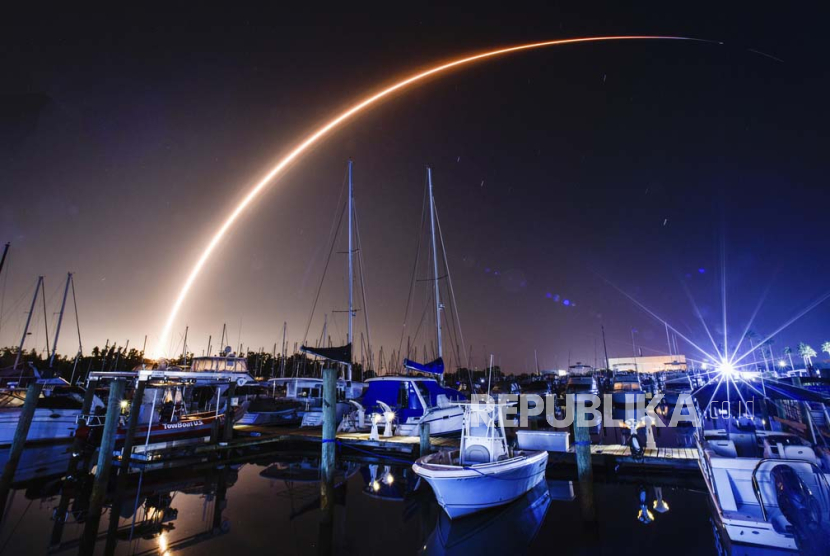REPUBLIKA.CO.ID, JAKARTA— A SpaceX rocket that was not in orbit made a temporary hole in the upper atmosphere, creating a bright blob of light in the sky. Now, scientists have warned that these “SpaceX auroras” that look like fiery red balls of light could cause unknown problems, although they do not pose a threat to the environment or life on Earth.
Reported LiveScience, Thursday (30/11/2023), researchers have known for decades that launching rockets into space can create holes in the upper ionosphere. This is the part of the atmosphere between 80 and 644 kilometers above the Earth’s surface where gases ionize, or release electrons. These “ionospheric holes” can stimulate gas molecules in this part of the atmosphere and trigger bright red streaks like aurora lights.
For example, in July, a SpaceX Falcon 9 rocket, carrying Starlink satellites into orbit, punched a hole over Arizona that gaped the sky. In September, a United States (US) Space Force rocket accidentally created an ionospheric hole over California, which created a faint red glow.
Now, astronomers at the McDonald Observatory in Texas have spotted a similar but unique red glow appearing long after SpaceX’s Falcon 9 rocket left Earth’s atmosphere. These lights, which are smaller and more spherical than the long streaks produced by rocket launches, are the result of ionospheric holes created by the rocket’s secondary boosters as they fall back to Earth after breaking free from the rocket, spaceweather.com reported.
Astronomers saw SpaceX’s first aurora aboard the observatory in February, and now they see “two to five auroras every month,” Stephen Hummel, astronomer and outreach program coordinator at McDonald Observatory, told Spaceweather.com. Hummel added the red ball was “very bright” and “easily visible to the naked eye”.
Ascending rockets and non-orbiting boosters trigger ionospheric holes by releasing fuel into the ionosphere, which causes ionized oxygen atoms to recombine, or change back into regular gas molecules.
This transformation excites the molecules and causes them to release red light, similar to when gas is excited by solar radiation during traditional aurora displays. This essentially creates a hole in the surrounding plasma, or ionized gas. But the recombined molecules will ionize, which closes the hole within 10 to 20 minutes.
SpaceX’s thrusters release fuel during a brief burn to propel falling debris to land in the Southern Atlantic Ocean instead of falling off land. According to Spaceweather.com, the resulting hole usually forms over the south-central US region about 90 minutes after launch at an altitude of about 300 km.
These holes are smaller and more circular than the holes opened by rocket launches, so the light produced is rounder and does not last as long. But they appear more often.
Just like larger light shows, ionospheric holes pose no danger to life on the Earth’s surface. However, “its impact on astronomical science is still being evaluated,” Hummel said. As a result, Hummel added, this is of “increasing concern” among researchers. Learning about these holes can also help scientists learn more about the ionosphere.
“Ionospheric density varies from night to night, so we can study chemical efficiency [ionosfer] by observing many events,” Jeffrey Baumgardner, a physicist at Boston University, told Spaceweather.com.
The red blob isn’t the only light show created by SpaceX’s rocket. The company’s rocket booster rotates and dumps its remaining fuel into space before de-orbiting, creating a cloud of tiny ice crystals. These crystals can sometimes reflect sunlight back to Earth, and the burning fuel creates bright spirals in the night sky, known as “SpaceX spirals.”
There have already been two big SpaceX spirals this year. The first occurs in January, when it appears to form over Mauna Kea in Hawaii, and the second occurs in April, when it shines during the traditional aurora show in Alaska. The number of SpaceX launches is increasing rapidly so auroras and spirals will likely become more common in the future.
2023-11-30 08:05:59
#SpaceX #Rocket #Accused #Creating #Hole #Atmosphere #Facts #Republika #Online


